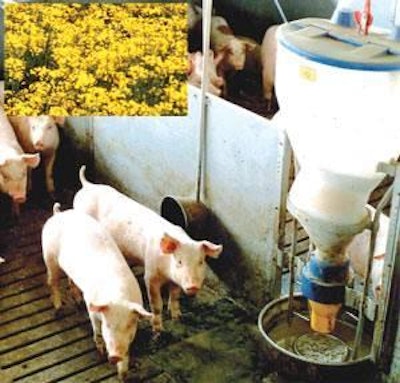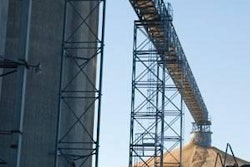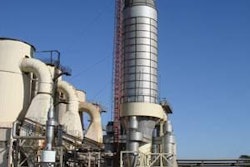
Think again before you start adding rapeseed oil to pig diets, say researchers in Denmark after conducting a series of trials with various vegetable oil sources as an alternative to animal fat. Variations in quality have been found for unrefined rapeseed oils sold on the European market. At the extreme, these differences were enough to undermine the productivity of weaned pigs. What is more, they negatively affected the processing properties of the pork from the resulting carcases.
Testing at the Danish Meat Research Institute had been initiated against a backdrop of concerns about the possibility of quality problems in pork products because of the increased use of vegetable oils to replace animal fats in many European pig feeds. In Denmark, as in Europe generally, some pig meat production agreements reflect the long-standing precautions against BSE (bovine spongiform encephalopathy) by specifying that animal-derived fat sources such as lard or tallow cannot be used. The imposition of more stringent standards has also reduced animal fat usage by substantially limiting appropriate supplies.
For Danish feed manufacturers as elsewhere, too, the list of possible dietary fatty acid ingredients is a long one. Apart from rapeseed oil they could opt to add palm oil and its derivatives, coconut oil, soybean oil, or various industrial co-products, all considered equally suitable in terms of their value for pig nutrition. High digestibility and price considerations have tended to favour using the oils extracted from rapeseed or coconut, but the Danes have been telling their pig feed manufacturers recently that the use of raw rapeseed oil cannot be recommended.
Fatty acid alternatives
A report since published in Denmark refers to results of three sub-trials in which different vegetable oil sources were tested as alternatives to pig fat in feeds for weaned pigs. One sub-trial checked coconut oil, rapeseed oil, palm oil, the palm fatty acid distillate PFAD, and a mix composed 50% of palm oil and 50% PFAD. The second test in the series compared raw rapeseed oil and PFAD with production figures from using pig fat, while the third comparison was of pig fat, rapeseed oil, and raw soybean oil. All diets were identical apart from the type of fat added at 5%.
Besides growth performance figures, the test calculated a production value per pig in monetary terms to reflect the pigs' biological response to the diet or fat source in question. This calculation assumed that the feed price was always the same, regardless of the fat source used.
Trial data showed the rapeseed oil to have reduced the production value of the pig by 9% on average when compared with animal fat, both having been included as 5% of the diet (see figure Rapeseed oil'). In one test, the growth performance of the pigs fell by as much as 16%. Such negative effects were probably due to aromatic substances in the oil (glucosinolate residues among them) giving an off-taste that affected the palatability of the feed, says the Danish report from the project New sources of feed fat for pigs'.
After trying 3% inclusions of several oil sources in the feed of finishing pigs, the research team concluded that the real alternatives to animal fat were palm oil, soybean oil, coconut oil, and the PFAD material from palm fatty-acid distillation. Adding 3% rapeseed oil to finisher feed made the carcase more difficult to process. The extra supply of unsaturated fatty acids from this addition meant a softer carcase fat that was at greater risk of rancidity as well as poorer ham and bacon yields, a longer drying time and a softer texture in salami-type fermented sausages.
By contrast, little difference in the production figures for weaned pigs had appeared when giving them either animal fat or soybean oil in their nursery diet. Feeding coconut oil aided fat digestibility and improved weaner productivity by 7% compared with a similar inclusion of animal fat. Palm oil also gave a better production value, by 8%. But the surprise came when the team tried the palm oil co-product PFAD either alone or in combination with palm oil.
Surprising performance of PFAD
In terms of its fatty acid composition, of course, palm oil is the vegetable source most similar to animal fat or lard, while coconut oil and soybean oil are more unsaturated. The Danish work confirmed that palm oil would support similar production results by weaned pigs to those obtained by feeding animal fat. Against expectations, however, comparable results were also obtained from using a half-and-half mix of palm oil with PFADdespite the fact that this had been estimated to have only 68% of the energy content of pig fat (see figure 'Palm oil').
A summary of production results from comparing the different fats and oils at 5% against pig fat in weaner feed also shows the value of palm oil and PFAD (see table 'Fats and oils'). These data also show the production values calculated at the time on the basis of pig prices in Denmark over the previous five years. These data confirm that no value differences were detected from using either a palm oil distillate alone or a 50/50 combination of PFAD with palm oil. When the data from a second trial were taken into account, the overall conclusion was that PFAD could be considered an alternative to pig fat and to soybean oil for inclusion in the diet of weaned pigs.
Analyses after adding 3% of various fat sources to finishing feed confirmed that the lipid source directly influenced the quality of the fat in the carcase of the slaughtered pig. More unsaturated fat was measured in carcases of pigs that had been given raw rapeseed oil. The iodine number in fat was 84, says the Danish report, indicating a risk of rancidity.
Parallel with these trials, digestibility trials at the Danish Institute of Agricultural Sciences with the same sources of fat and the same diets showed that mixed oils had the lowest digestibility values relative to animal fat and therefore were considered less desirable as a lipid source unless low prices favoured their use. Raw rapeseed oil and coconut oil came out on top in this assessment while the other oils tested were considered moderately digestible.
 0609FIwarning4
0609FIwarning4
Production results and production value of various fats and oils in weaner pig feeds demonstrate surprisingly high performance of PFAD.
Although the rapeseed and coconut oils shared the distinction of having the highest digestibility measurements, however, the Danes assert that coconut would be the better choice for replacing animal fat in weaner and finisher pig diets. They have advised against rapeseed oil because of its negative effects on weaner productivity and on the meat quality characteristics of final carcases.
The researchers concluded that the existing energy evaluations of palm oil and PFAD were probably too low. More recently, in fact, the digestibility measurements from these trials have provided the basis for a complete revision of the energy ratings attributed to each of the various fat sources tested.





.jpg?auto=format%2Ccompress&fit=crop&h=167&q=70&w=250)












